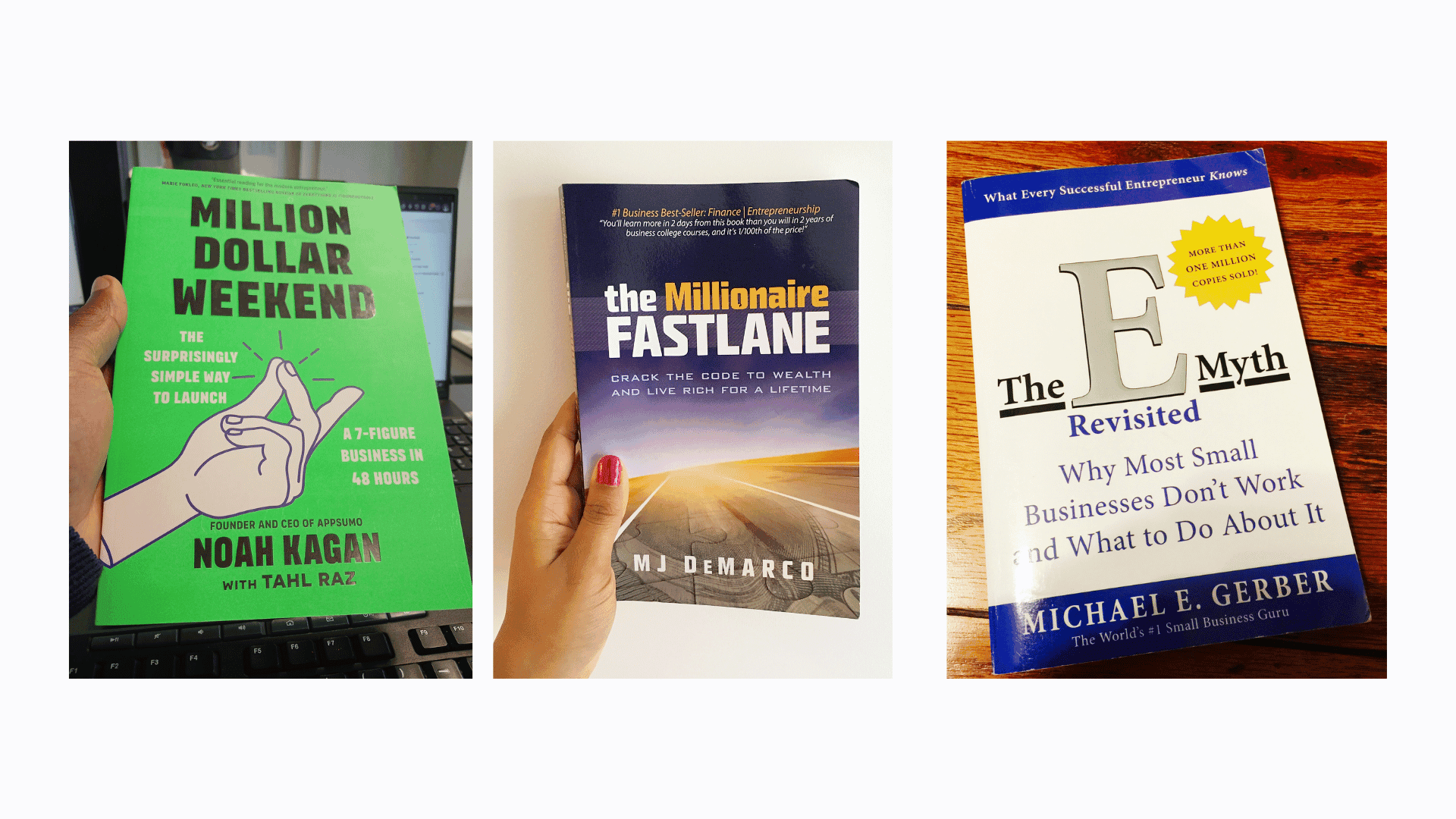How to Start a Business with No Ideas: A Step-by-Step Tutorial
How to Start a Business with No Ideas: A Step-by-Step Tutorial



Want to Start a Business? But No Ideas? Let’s Fix That.
Want to Start a Business? But No Ideas? Let’s Fix That.
You’ve probably thought about it a hundred times – “I want to start a business, but I have no idea what to do.” You might even think everyone else has these amazing, money-making business ideas while you’re stuck.
But guess what? Most successful entrepreneurs didn’t start with “genius” ideas. They started by solving problems – real, simple problems that they or others faced. You don’t need a flash of inspiration. You just need a process.
Imagine having a clear, step-by-step guide that turns you from “I have no clue what business to start” to “I’m building something people actually want.”
If you’re ready to go from zero to launch, keep reading. I’ll show you how to find, validate, and kick off a business with no ideas – and without a lot of cash.
You’ve probably thought about it a hundred times – “I want to start a business, but I have no idea what to do.” You might even think everyone else has these amazing, money-making business ideas while you’re stuck.
But guess what? Most successful entrepreneurs didn’t start with “genius” ideas. They started by solving problems – real, simple problems that they or others faced. You don’t need a flash of inspiration. You just need a process.
Imagine having a clear, step-by-step guide that turns you from “I have no clue what business to start” to “I’m building something people actually want.”
If you’re ready to go from zero to launch, keep reading. I’ll show you how to find, validate, and kick off a business with no ideas – and without a lot of cash.
Contents
Boost your business visibility to thousands of engaged readers!
Get Featured on 100+ pages across the FounderNoon website.
One month stretch ⇢ $100
Three-month stretch ⇢ $250
Boost your business visibility to thousands of engaged readers!
Get Featured on 100+ pages across the FounderNoon website.
One month stretch ⇢ $100
Three-month stretch ⇢ $250
Contents
Step 1: Forget Ideas – Start with Problems
Step 1: Forget Ideas – Start with Problems
When people think about starting a business, they often get caught up in searching for a million-dollar idea. The next big thing. But here’s the truth: the best businesses don’t come from "aha" moments or flashes of brilliance. They come from solving annoyances, frustrations, and everyday problems.

Building a business doesn’t require genius-level creativity. It requires a mindset shift—from chasing ideas to spotting problems. Look around. Notice what’s broken. Think about the things that irritate you and the stuff that feels way harder than it should be. These moments of irritation are goldmines. They’re the seeds of profitable business ideas.
Here’s the magic formula: annoying, repetitive issues = great business ideas. It could be as simple as a task that feels painfully slow or a process that needs a digital shortcut. These “pain points” are everywhere.
Examples of Problem-Based Business Ideas
Need proof? Here are some killer businesses born from problems, not ideas:
Noise-Canceling Headphones: A genius thought, “What if we could cancel out the noise of crying babies and engine hum on flights?” They didn’t invent headphones—they just solved an annoyance.
Airbnb: The founders had a problem—affording rent in San Francisco. They also had extra space and realized there were other people like them who needed cheaper, homier places to stay. Simple problem, huge industry.
Grammarly: People were struggling with grammar and spelling. Writing was tough. Grammarly came along and made clear, polished writing easy. One pain point solved for millions.
The common thread? These companies didn’t start by saying, “Let’s think of a big idea.” They said, “Let’s fix something that’s annoying people.”
💡 Action Step: Start Your Problem List
You don’t need to reinvent the wheel to start a business—just a notepad and some curiosity. Spend one day writing down all the little problems you see around you. Ask friends and family what annoys them.
These aren’t just problems; they’re hidden business ideas. You’ll be surprised at how many gems you uncover by looking at the world through the “problem-solving” lens. Get out of the idea-hunting mindset and start noticing problems.
When people think about starting a business, they often get caught up in searching for a million-dollar idea. The next big thing. But here’s the truth: the best businesses don’t come from "aha" moments or flashes of brilliance. They come from solving annoyances, frustrations, and everyday problems.

Building a business doesn’t require genius-level creativity. It requires a mindset shift—from chasing ideas to spotting problems. Look around. Notice what’s broken. Think about the things that irritate you and the stuff that feels way harder than it should be. These moments of irritation are goldmines. They’re the seeds of profitable business ideas.
Here’s the magic formula: annoying, repetitive issues = great business ideas. It could be as simple as a task that feels painfully slow or a process that needs a digital shortcut. These “pain points” are everywhere.
Examples of Problem-Based Business Ideas
Need proof? Here are some killer businesses born from problems, not ideas:
Noise-Canceling Headphones: A genius thought, “What if we could cancel out the noise of crying babies and engine hum on flights?” They didn’t invent headphones—they just solved an annoyance.
Airbnb: The founders had a problem—affording rent in San Francisco. They also had extra space and realized there were other people like them who needed cheaper, homier places to stay. Simple problem, huge industry.
Grammarly: People were struggling with grammar and spelling. Writing was tough. Grammarly came along and made clear, polished writing easy. One pain point solved for millions.
The common thread? These companies didn’t start by saying, “Let’s think of a big idea.” They said, “Let’s fix something that’s annoying people.”
💡 Action Step: Start Your Problem List
You don’t need to reinvent the wheel to start a business—just a notepad and some curiosity. Spend one day writing down all the little problems you see around you. Ask friends and family what annoys them.
These aren’t just problems; they’re hidden business ideas. You’ll be surprised at how many gems you uncover by looking at the world through the “problem-solving” lens. Get out of the idea-hunting mindset and start noticing problems.
Step 2: Feed Your Brain with Business Books and Blogs
Step 2: Feed Your Brain with Business Books and Blogs
Recommended Books to Spark Your Mindset

Reading can shift your mindset and help you think like an entrepreneur. Here are three game-changing books that will do just that:
The Millionaire Fastlane by MJ DeMarco
This isn’t your typical “get rich” spiel. MJ DeMarco walks you through what it takes to break free from the 9-to-5 grind. No fluffy motivational talk, just the raw mechanics of wealth-building. He breaks down why the slow-lane path—school, job, retire—is a ticket to mediocrity and how to think about business from a “fastlane” mindset. If you’re done daydreaming and want to know how wealth actually happens, this book's your blueprint.
Million Dollar Weekend by Noah Kagan
Noah’s the guy who made products at Facebook and Mint, then built an eight-figure business of his own. Here, he lays out a simple, actionable approach to generating and validating business ideas quickly. It’s about taking action now, not someday. If you’ve been sitting on an idea, thinking, “Maybe later,” Noah’s words will shake that out of you. “Start by Saturday.” This book shows you how to validate ideas fast, without needing a whole business plan or VC funding.
The E-Myth Revisited by Michael E. Gerber
This one’s a bit of a wake-up call. Gerber dives into why so many small businesses fail—and it’s not what you think. It’s not about the product or service; it’s about the structure and vision behind it. You can be the best baker in town, but if you don’t know how to build a business, you’ll never get out of the kitchen. Gerber explains what it means to work on your business, not in it, so you don’t get lost in the weeds.
Blogs and Communities to Keep Your Ideas Flowing
Reading’s great, but sometimes you need fresh perspectives straight from the source. Fortunately, the internet’s buzzing with real founders sharing their lessons, and mistakes. Here are a few places where entrepreneurial energy flows:
Foundernoon
Think of it as a mini MBA from people who are actually out there doing the thing. This site is stacked with success stories, startup tips, and lessons learned the hard way. Real founders, real insights. It’s like your daily dose of “If they can do it, why not me?”
Indie Hackers
A community of indie entrepreneurs who have no interest in VC funding or tech unicorn dreams. These are regular folks building businesses on their own terms. They share the ups and downs, the tactics that worked, the ones that failed, and why. If you want to start a business but feel alone, you’ll find your tribe here.
Failory
Sometimes the best lessons come from failure. Failory is a collection of startup post-mortems—stories from founders who tried, failed, and grew from it. It’s humbling and refreshing to read about real struggles and mistakes, plus the lessons they learned so you don’t have to make them yourself.
💡Action Step: Build Your Knowledge in 30 Minutes a Day
This isn’t about binge-reading. Take 30 minutes a day to read one chapter or article—no more. That’s enough to keep your mind active without overwhelming it. Let it become a habit. You’ll find that the consistent spark of new ideas, insights, and challenges slowly rewires your thinking. Problems start looking less like walls and more like opportunities in waiting.
Recommended Books to Spark Your Mindset

Reading can shift your mindset and help you think like an entrepreneur. Here are three game-changing books that will do just that:
The Millionaire Fastlane by MJ DeMarco
This isn’t your typical “get rich” spiel. MJ DeMarco walks you through what it takes to break free from the 9-to-5 grind. No fluffy motivational talk, just the raw mechanics of wealth-building. He breaks down why the slow-lane path—school, job, retire—is a ticket to mediocrity and how to think about business from a “fastlane” mindset. If you’re done daydreaming and want to know how wealth actually happens, this book's your blueprint.
Million Dollar Weekend by Noah Kagan
Noah’s the guy who made products at Facebook and Mint, then built an eight-figure business of his own. Here, he lays out a simple, actionable approach to generating and validating business ideas quickly. It’s about taking action now, not someday. If you’ve been sitting on an idea, thinking, “Maybe later,” Noah’s words will shake that out of you. “Start by Saturday.” This book shows you how to validate ideas fast, without needing a whole business plan or VC funding.
The E-Myth Revisited by Michael E. Gerber
This one’s a bit of a wake-up call. Gerber dives into why so many small businesses fail—and it’s not what you think. It’s not about the product or service; it’s about the structure and vision behind it. You can be the best baker in town, but if you don’t know how to build a business, you’ll never get out of the kitchen. Gerber explains what it means to work on your business, not in it, so you don’t get lost in the weeds.
Blogs and Communities to Keep Your Ideas Flowing
Reading’s great, but sometimes you need fresh perspectives straight from the source. Fortunately, the internet’s buzzing with real founders sharing their lessons, and mistakes. Here are a few places where entrepreneurial energy flows:
Foundernoon
Think of it as a mini MBA from people who are actually out there doing the thing. This site is stacked with success stories, startup tips, and lessons learned the hard way. Real founders, real insights. It’s like your daily dose of “If they can do it, why not me?”
Indie Hackers
A community of indie entrepreneurs who have no interest in VC funding or tech unicorn dreams. These are regular folks building businesses on their own terms. They share the ups and downs, the tactics that worked, the ones that failed, and why. If you want to start a business but feel alone, you’ll find your tribe here.
Failory
Sometimes the best lessons come from failure. Failory is a collection of startup post-mortems—stories from founders who tried, failed, and grew from it. It’s humbling and refreshing to read about real struggles and mistakes, plus the lessons they learned so you don’t have to make them yourself.
💡Action Step: Build Your Knowledge in 30 Minutes a Day
This isn’t about binge-reading. Take 30 minutes a day to read one chapter or article—no more. That’s enough to keep your mind active without overwhelming it. Let it become a habit. You’ll find that the consistent spark of new ideas, insights, and challenges slowly rewires your thinking. Problems start looking less like walls and more like opportunities in waiting.
Step 3: Identify and Find Your Potential Customers
Step 3: Identify and Find Your Potential Customers

Alright, you’ve got your big idea. But before you dive headfirst into developing it, you need to make sure there’s a crowd waiting to buy what you’re selling. There’s no point building something if no one’s interested. So, let’s break it down, step by step.
1. Define Your Target Audience
This is the first and most crucial step. Who actually has the problem you’re trying to solve? Dig deep. Think about the details: What’s their age? What’s their job? Where do they live? What keeps them up at night? Are they work-from-home parents, tech enthusiasts, college students? Narrowing down these specifics is key. Because once you’ve got a clear picture of your ideal customer, you’ll know where to find them.
2. Explore Forums and Online Communities
The internet is a goldmine for finding people talking about their problems. Think Reddit, Quora, and Facebook Groups. What challenges come up? What questions are people asking? These insights are free, right there in the open. You just have to look.
3. Use Surveys to Collect Feedback
People love talking about their problems, especially when it feels like someone’s listening. Use this to your advantage by creating a simple survey (Google Forms or Typeform work perfectly). Keep the questions open-ended to encourage honest, detailed responses. For example: “What’s your biggest challenge with [your topic]?” or “What would a dream solution look like for you?” This feedback is pure gold and will help you understand if there’s actual demand for your solution.
4. Spy on Competitors’ Customers
Now, this one’s a bit sneaky but super effective. Visit your competitors’ social media pages and read the comments. Customers are vocal about what they love and hate. What do they keep praising? What do they complain about? What would they change if they could? Use this data to refine your idea – or even build something better.
5. Engage with People Directly
You don’t always have to search far and wide. Ask people in your own circle who might fit your ideal customer profile. Family, friends, colleagues. A casual conversation can give you insights that hours of online research can’t. Ask them directly: “If I offered this solution, would you pay for it?” Be straightforward – their answers might surprise you.
💡Action Step:
Define one customer profile right now. Not tomorrow. Today. Then try one of the methods above. You'll start to see if your idea has legs, if there's actual demand, and if real people are ready to pay for it.

Alright, you’ve got your big idea. But before you dive headfirst into developing it, you need to make sure there’s a crowd waiting to buy what you’re selling. There’s no point building something if no one’s interested. So, let’s break it down, step by step.
1. Define Your Target Audience
This is the first and most crucial step. Who actually has the problem you’re trying to solve? Dig deep. Think about the details: What’s their age? What’s their job? Where do they live? What keeps them up at night? Are they work-from-home parents, tech enthusiasts, college students? Narrowing down these specifics is key. Because once you’ve got a clear picture of your ideal customer, you’ll know where to find them.
2. Explore Forums and Online Communities
The internet is a goldmine for finding people talking about their problems. Think Reddit, Quora, and Facebook Groups. What challenges come up? What questions are people asking? These insights are free, right there in the open. You just have to look.
3. Use Surveys to Collect Feedback
People love talking about their problems, especially when it feels like someone’s listening. Use this to your advantage by creating a simple survey (Google Forms or Typeform work perfectly). Keep the questions open-ended to encourage honest, detailed responses. For example: “What’s your biggest challenge with [your topic]?” or “What would a dream solution look like for you?” This feedback is pure gold and will help you understand if there’s actual demand for your solution.
4. Spy on Competitors’ Customers
Now, this one’s a bit sneaky but super effective. Visit your competitors’ social media pages and read the comments. Customers are vocal about what they love and hate. What do they keep praising? What do they complain about? What would they change if they could? Use this data to refine your idea – or even build something better.
5. Engage with People Directly
You don’t always have to search far and wide. Ask people in your own circle who might fit your ideal customer profile. Family, friends, colleagues. A casual conversation can give you insights that hours of online research can’t. Ask them directly: “If I offered this solution, would you pay for it?” Be straightforward – their answers might surprise you.
💡Action Step:
Define one customer profile right now. Not tomorrow. Today. Then try one of the methods above. You'll start to see if your idea has legs, if there's actual demand, and if real people are ready to pay for it.
Step 4: Ignore Self-Doubt – Start with What You Have
Step 4: Ignore Self-Doubt – Start with What You Have
Don’t Let Self-Doubt Stop You

Every entrepreneur faces that voice in their head, the one that says, “Why would anyone choose my business over all the others out there?” It’s the voice of self-doubt, and trust me, you’re not alone in hearing it. But here’s the truth: you don’t need to be perfect to start. If you wait for everything to be “just right,” you might never take the leap. The key is to start now.
So many successful entrepreneurs you admire didn’t have it all figured out when they started. They were just like you – unsure, scared, and overwhelmed by the challenge ahead. The difference? They didn’t let those feelings paralyze them. They kept moving forward, one small step at a time. Perfection is a myth. What matters is that you start.
Start with an MVP (Minimum Viable Product)
Instead of trying to launch a fully polished product or service, focus on creating an MVP – a Minimum Viable Product. This is the simplest version of your idea, just enough to show the world what you’re offering. Maybe it’s a one-page website with a basic description of your product. Maybe it’s a social media page where you can start talking to your audience. Or even just a pitch that explains what your business is all about.
The key is that an MVP isn’t about being perfect. It’s about testing your idea and getting real feedback from real people. Once you have that feedback, you can improve, refine, and build on what you already have. Perfection comes later.
💡Action Step: Define One Small Step You Can Take Today
What’s one tiny action you can take today to bring your idea to life? Maybe it’s registering a domain name. Maybe it’s drafting a business plan. Or even simpler – start by creating a one-page website or setting up a basic social media profile. It doesn’t need to be perfect. What matters is that you’re making progress.
Remember, done is better than perfect. Start now, and let the momentum carry you forward.
Don’t Let Self-Doubt Stop You

Every entrepreneur faces that voice in their head, the one that says, “Why would anyone choose my business over all the others out there?” It’s the voice of self-doubt, and trust me, you’re not alone in hearing it. But here’s the truth: you don’t need to be perfect to start. If you wait for everything to be “just right,” you might never take the leap. The key is to start now.
So many successful entrepreneurs you admire didn’t have it all figured out when they started. They were just like you – unsure, scared, and overwhelmed by the challenge ahead. The difference? They didn’t let those feelings paralyze them. They kept moving forward, one small step at a time. Perfection is a myth. What matters is that you start.
Start with an MVP (Minimum Viable Product)
Instead of trying to launch a fully polished product or service, focus on creating an MVP – a Minimum Viable Product. This is the simplest version of your idea, just enough to show the world what you’re offering. Maybe it’s a one-page website with a basic description of your product. Maybe it’s a social media page where you can start talking to your audience. Or even just a pitch that explains what your business is all about.
The key is that an MVP isn’t about being perfect. It’s about testing your idea and getting real feedback from real people. Once you have that feedback, you can improve, refine, and build on what you already have. Perfection comes later.
💡Action Step: Define One Small Step You Can Take Today
What’s one tiny action you can take today to bring your idea to life? Maybe it’s registering a domain name. Maybe it’s drafting a business plan. Or even simpler – start by creating a one-page website or setting up a basic social media profile. It doesn’t need to be perfect. What matters is that you’re making progress.
Remember, done is better than perfect. Start now, and let the momentum carry you forward.

















2,678+ people enjoy it
➤ Every week, we dig up stories of how regular people started and grew their businesses—
➤ Plus the marketing hacks that won them customers.
➤ Then, we share those insights with you.
➤ Every week, we dig up stories of how regular people started and grew their businesses—
➤ Plus the marketing hacks that won them customers.
➤ Then, we share those insights with you.
Step 5: Don’t Start a Business You Don’t Care About
Step 5: Don’t Start a Business You Don’t Care About
Why Passion Matters
Running a business takes effort, and if you don’t care about what you’re doing, burnout is almost guaranteed. When you’re passionate, you’ll be more patient, resilient, and willing to stick it out when things get tough.
Think about this: you’re going to spend a lot of time working on this business. If you’re not invested in it, why should your customers be? People can sense authenticity. If you genuinely care about your business and your customers, it’ll show.
Why Passion Matters
Running a business takes effort, and if you don’t care about what you’re doing, burnout is almost guaranteed. When you’re passionate, you’ll be more patient, resilient, and willing to stick it out when things get tough.
Think about this: you’re going to spend a lot of time working on this business. If you’re not invested in it, why should your customers be? People can sense authenticity. If you genuinely care about your business and your customers, it’ll show.
Step 6: Start Small – Test Your Solution Without Spending Big
Step 6: Start Small – Test Your Solution Without Spending Big
Low-Cost Ways to Test Your Idea
You don’t need a huge investment to start. In fact, you shouldn’t. There are plenty of low-cost ways to test your business idea without draining your wallet. It’s all about getting feedback early and learning fast, without the need for big risks. Here are some simple ways to get started:
Landing Pages:
Create a simple landing page to gauge interest. Tools like Carrd or Wix let you build a basic website in just a few minutes, and you don’t need to spend much to get it live. A landing page lets you showcase your idea and collect email addresses from people who are interested. It’s a low-risk way to test the waters and see if people are willing to learn more or sign up.
Crowdfunding: Sites like Kickstarter and Indiegogo allow you to test your concept and raise funds before fully launching.
Gather Customer Feedback and Iterate
Launching doesn’t mean it’s over. In fact, it’s just the beginning. Collecting feedback from real users is critical for growth. Many successful businesses didn’t get it right on the first try—but they listened to their customers and kept improving.
You can’t guess what your audience wants. You have to ask. Whether it’s through surveys, one-on-one chats, or watching how people engage with your content, the feedback you get is invaluable. Don’t be afraid to iterate on your idea—what you launch doesn’t have to be perfect. The important part is to listen, adapt, and make your offering better over time.
💡 Action Step:
Now, it’s time to take action. Pick one of the low-cost tests mentioned above. Maybe it’s a social media post, a landing page, or even a survey. Put it out there, collect feedback, and learn what people think. Even if you don’t get immediate results, remember—it’s a learning process. Each step takes you closer to the validation you need to move forward with confidence.
Low-Cost Ways to Test Your Idea
You don’t need a huge investment to start. In fact, you shouldn’t. There are plenty of low-cost ways to test your business idea without draining your wallet. It’s all about getting feedback early and learning fast, without the need for big risks. Here are some simple ways to get started:
Landing Pages:
Create a simple landing page to gauge interest. Tools like Carrd or Wix let you build a basic website in just a few minutes, and you don’t need to spend much to get it live. A landing page lets you showcase your idea and collect email addresses from people who are interested. It’s a low-risk way to test the waters and see if people are willing to learn more or sign up.
Crowdfunding: Sites like Kickstarter and Indiegogo allow you to test your concept and raise funds before fully launching.
Gather Customer Feedback and Iterate
Launching doesn’t mean it’s over. In fact, it’s just the beginning. Collecting feedback from real users is critical for growth. Many successful businesses didn’t get it right on the first try—but they listened to their customers and kept improving.
You can’t guess what your audience wants. You have to ask. Whether it’s through surveys, one-on-one chats, or watching how people engage with your content, the feedback you get is invaluable. Don’t be afraid to iterate on your idea—what you launch doesn’t have to be perfect. The important part is to listen, adapt, and make your offering better over time.
💡 Action Step:
Now, it’s time to take action. Pick one of the low-cost tests mentioned above. Maybe it’s a social media post, a landing page, or even a survey. Put it out there, collect feedback, and learn what people think. Even if you don’t get immediate results, remember—it’s a learning process. Each step takes you closer to the validation you need to move forward with confidence.
Step 7: Scale When You See Results
Step 7: Scale When You See Results
Building a Sustainable Model
Once you start getting traction, think about how to make your business sustainable. This could mean raising prices, launching additional services, or finding partnerships to reach more customers. Remember, scaling doesn’t mean you need to do it all at once – it’s a gradual process.
Focus on Profitability, Not Just Revenue
As you scale, keep a close eye on your profit margins. You’re not just looking for sales; you want a profitable business. Avoid common pitfalls like underpricing or trying to expand too quickly without understanding your costs.
Building a Sustainable Model
Once you start getting traction, think about how to make your business sustainable. This could mean raising prices, launching additional services, or finding partnerships to reach more customers. Remember, scaling doesn’t mean you need to do it all at once – it’s a gradual process.
Focus on Profitability, Not Just Revenue
As you scale, keep a close eye on your profit margins. You’re not just looking for sales; you want a profitable business. Avoid common pitfalls like underpricing or trying to expand too quickly without understanding your costs.
Get Started, Even if It’s Small
Get Started, Even if It’s Small
Starting a business doesn’t require a perfect idea, lots of money, or endless knowledge. You just need to solve a problem, understand your audience, and take one step at a time. The biggest mistake is doing nothing because you’re waiting for the “right” idea.
In the words of successful entrepreneurs: the best time to start is now. So if you’ve ever thought, “I want to start my own business,” remember – there’s no better time than today.
Take action, learn as you go, and build a business that matters.
P.S. I’ve got a weekly newsletter where I share stories about founders who have started successful online businesses, growth strategies, business ideas, and tips to start/grow your own business. I would love for you to join here
Starting a business doesn’t require a perfect idea, lots of money, or endless knowledge. You just need to solve a problem, understand your audience, and take one step at a time. The biggest mistake is doing nothing because you’re waiting for the “right” idea.
In the words of successful entrepreneurs: the best time to start is now. So if you’ve ever thought, “I want to start my own business,” remember – there’s no better time than today.
Take action, learn as you go, and build a business that matters.
P.S. I’ve got a weekly newsletter where I share stories about founders who have started successful online businesses, growth strategies, business ideas, and tips to start/grow your own business. I would love for you to join here






